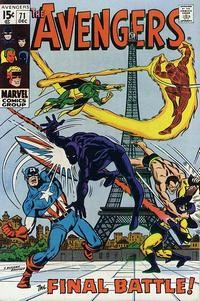 The 70’s was a time of experimentation for comics (and some comic creators I’ve been told.) During the Bronze Age we saw comics featuring movie monsters, pulp heroes and martial artists. Perhaps one of the most interesting trends of this time was the rediscovery of long forgotten Golden Age (GA from herein) heroes by both DC and Marvel.
The 70’s was a time of experimentation for comics (and some comic creators I’ve been told.) During the Bronze Age we saw comics featuring movie monsters, pulp heroes and martial artists. Perhaps one of the most interesting trends of this time was the rediscovery of long forgotten Golden Age (GA from herein) heroes by both DC and Marvel.At Marvel, long time GA Fan Roy Thomas re-introduced a group who would become known as the Invaders to modern readers in the pages of Avengers 71 in December 1969. In the story, Kang summons the World War II versions of Namor, Captain America and the GA Human Torch to battle the present day Avengers.
It’s really a pretty good story if you overlook the part where Namor is stymied by a swarm of Bees. It ends with all three of the GA heroes being taken down by the Vision, who fittingly was himself inspired by a GA character.
 Over at DC, In October 1973, Len Wein had been challenged by Julius Schwartz totop his fantastic three issue run of Justice League of America wherein he reintroduced the Seven Soldiers of Victory (JLA 100 – 102). Len’s solution was to tell a two part story with another group GA heroes, characters from the now defunct Quality Comics publishing company. This story would be called Crisis on Earth X and it featured Uncle Sam, The Human Bomb, The Black Condor, Phantom Girl, Doll Man and the Ray. These characters had never teamed up before, but this grouping would eventually be known collectively as the Freedom Fighters.
Over at DC, In October 1973, Len Wein had been challenged by Julius Schwartz totop his fantastic three issue run of Justice League of America wherein he reintroduced the Seven Soldiers of Victory (JLA 100 – 102). Len’s solution was to tell a two part story with another group GA heroes, characters from the now defunct Quality Comics publishing company. This story would be called Crisis on Earth X and it featured Uncle Sam, The Human Bomb, The Black Condor, Phantom Girl, Doll Man and the Ray. These characters had never teamed up before, but this grouping would eventually be known collectively as the Freedom Fighters.But before we get too deep into the Bronze Age adventures of these heroes, let’s examine their origins. The prototype of the Invaders can be found in the pages of the All Winners Squad 19 published in the Fall of 1946.
Called the All-Winners Squad, this team was much like the Bronze Age Invaders, but all of their adventures took place in the post World War II era. One of the most interesting things about this series is that it introduced the concept of superheroes who didn’t quite get along with each other – a theme Stan Lee would mine for gold in the 1960’s.
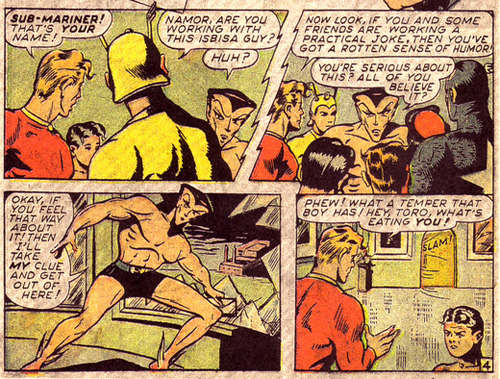
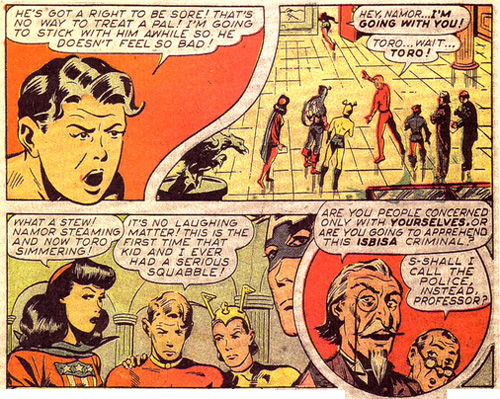
After their initial reappearances the public was clamoring for more of both groups of heroes. (And by public, I mean Roy Thomas.) The first to get their own series was the Invaders, who returned in the pages of Giant Sized Invaders #1 in 1975 before getting their own ongoing series in August of 1975. Written by Roy Thomas (surprise.) and initially illustrated by Frank Robbins, the series ran for 41 issues. (Which is about 4 times longer than a typical series runs today.)
Frank Robbins was a fitting choice for the series because he had been a comic strip artist during the GA having worked on Scorchy Smith for 5 years and creating Johnny Hazard in 1944. His distinctive lines, panel compositions and use of black were quite a departure from the popular photo realist illustrators of the time, but it gave the Invaders a very authentic GA feel to it.
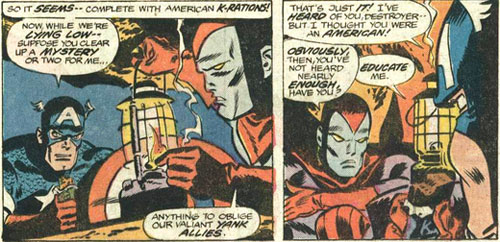
During their time together, Thomas and Robbins brought back a treasure trove of GA heroes, as well as introducing many of their own. Some of the more notable were Scarlet Scarab (Roy's tip of the hat to the Blue Beetle), The Liberty Legion, The Destroyer, Union Jack and Spitfire.
The dizzying array of character Thomas brought into the book has always made it a favorite of mine. In many ways with its multitude of GA heroes and offbeat cameos using Thor, Dr. Doom and the Frankenstein Monster, it’s like Thomas was creating his own mini-Marvel Universe. In WW II, Thomas had created his own pocket universe from whence any story could be told. Because of his extraordinary knowledge and respect for the Golden Age stories, Roy Thomas was able to architect a richer and better connected WW II history for the Marvel Universe. The WW II setting also allowed Thomas to use established Marvel characters in ways that were perhaps more fitting vis a vis their initial conceptions.
There are some notable differences between the GA portrayal of WW II in comics and the Bronze Age version most notable are the levels of violence in the GA stories. It wasn’t uncommon to see Captain America shooting the enemy point blank with a machine gun in the 1940’s.
Or Bucky smiling while he sprays the enemy with a Flame Thrower.
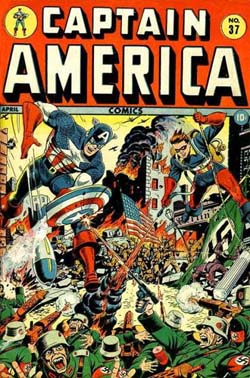
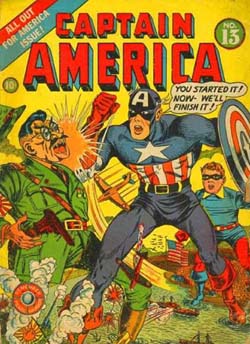
Another aspect of the Bronze Age adventures was the use of minority characters. As in many forms of media in the 40’s, how minorities were drawn and written in comics could be very insensitive and stereotypical at times.
However, in the Invaders, it’s not hard to see the influence of the more socially enlightened Bronze Age in many stories especially with the introduction of the multicultural Kid Commandos in issue 28.
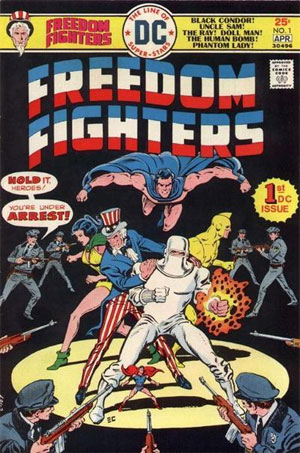 Meanwhile DC was taking a different tact with their GA heroes. When the Freedom Fighters first premiered in their ongoing series in April 1976, they would no longer be fighting WW II on Earth X, but would instead be dropped cold in modern day Earth 1 DC universe.
Meanwhile DC was taking a different tact with their GA heroes. When the Freedom Fighters first premiered in their ongoing series in April 1976, they would no longer be fighting WW II on Earth X, but would instead be dropped cold in modern day Earth 1 DC universe.Written by Gerry Conway and Martin Pasko with art by Rik Estrada, this series invoked another aspect of the Bronze Age in that the heroes were almost always at odds with authority. Using a theme that had worked well enough in his Spider-Man stories, Conway has the Quality characters on the run as fugitives from the law for most of the series.
If this had been the Doom Patrol or Titans East, then such a storyline might have been effective. However, my 12 year old mind found the idea that Uncle Freaking Sam was wanted by the police a little hard to swallow.
Setting the stories in contemporary Earth 1 was blessing and a curse for the Freedom Fighters. On one hand it allowed them to have current day guest stars like Wonder Woman, Batgirl and Batwoman. On the flipside, with their antiquated GA powers, some of the characters seemed lackluster when compared to people like Firestorm or Green Lantern.
Most likely in an effort to make the characters more exciting or equal to their Bronze Age peers, some of the Quality heroes found themselves gifted with new powers. The Phantom Lady gained the ability to become ethereal, Doll Man gained Telekinesis and Black Condor gained Telepathy. Along the same lines, the Human Bomb was given an energy damper so he could remove his radiation suit from time to time.
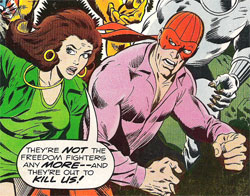 In issue 11, Firebrand, another Quality character was introduced, but this was hardly enough to grab reader’s attention and by issue 15 the series was cancelled – the first victim of what would later be called the DC Implosion.
In issue 11, Firebrand, another Quality character was introduced, but this was hardly enough to grab reader’s attention and by issue 15 the series was cancelled – the first victim of what would later be called the DC Implosion.One of the highlights of both series would most likely be the unofficial crossover of the Invaders with the Freedom Fighters when both groups fought the Crusaders. As Freedom Fighter editor Bob Rozakis explains…
In an editorial feat that would nearly impossible in this day and age, DC and Marvel managed to pull off this unofficial crossover such that the issues came out one after the other with The Invaders portion coming out in March and April
"As I recall it, I had come up with the idea of using the Crusaders...in Freedom Fighters and joked with then-editor Tony Isabella that it would be really funny if (Invaders writer) Roy Thomas used a version of the FFers in Invaders and called them the Crusaders as well. I believe it was actually Tony who spoke with Roy and suggested the unofficial crossover… but neither Roy nor I got to see these alternate-reality versions of our teams until the books were published."
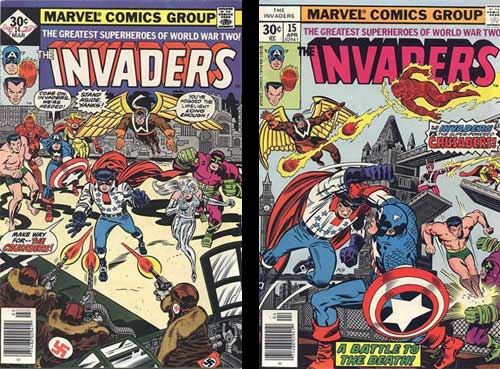
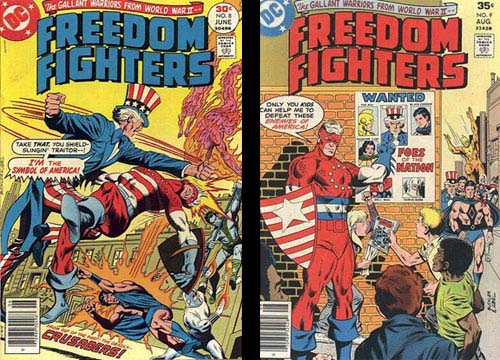
And while the Invaders didn’t jazz up any of it’s teams powers, it did "superhero-ize" the GA by giving them more of Silver Age/Bronze Age tropes--teams, villian organizations and more standard origins. In a sense, the Invaders begins Marvel retconning its GA to make it more congruent with the styles/sensibilites of the "modern era." This would begin a trend in comics.
It could be argued that this revamping of the GA heroes with such modern Age sensibilities within a self contained universe foreshadowed the Ultimate universe formula in many ways. Roy Thomas gave us the character's and historical situations familiar to the Golden Age but, well, Marvelized them (to coin a phrase) for new readers. Now the Golden Age would have the same tropes and story beats as comics in set in the current era. This whole "comics history makeover" approach woulld have a lot of traction in Marvel to come, as it was the stated goal behind the Ultimate Universe's creation.
On the flipside, the unsuccessful efforts to use the Quality characters in the DC universe, first in their own series, and then later in All Star Squadron after Crisis on Infinite Earths, demonstrated the problems inherent in DC’s wish to have simplified continuity.
So ends our analysis of the alchemy wherein Marvel took gold, turned it into bronze and turned it back into Gold again, as the Invaders were the unlikely template for Marvel’s Ultimate Comics. Meanwhile, at DC, their gold touch seems to have waned. The Quality characters, who should have been a boon to DC, became the unwitting harbingers of the crisis of continuity that has plagued DC ever since.

2 comments:
I have a fair number of Invaders, and a few Freedom Fighters including: FF 9, and Invaders 14, Now that I've been reminded of them and the kind of cross over I'm going to have to track Invaders 15 and FF 8.
**************
I really enjoy Robbins art it's why i picked up an issue out of the back issue bin, but the issues I had of FF were kind of a let down, and I like the orig. characters just not the story they were put in with Freedom Fighters.
Yeah, I agree with you about the Freedom Fighters - I'm not wild about the new series DC is putting out with the characters either. I see what Marvel has done with The Twelve and what Superheroes Project has done with Public Domain characters, and I think there are some good (and bad) things about both series, but with DC's new FF series, not so much.
Post a Comment